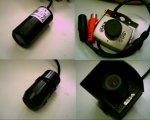sbdwag
0
- Joined
- May 21, 2009
- Messages
- 135
- Points
- 0
Ive heard many people say that many IR has difficulty burning many objects because of the wavelength.
I know from experience a 650nm 300 mw is barely able to burn white paper while a 150mw 405nm can burn thru easily.
Question is will a 3.2 W have problems burning anything
regards
sbdwag
I know from experience a 650nm 300 mw is barely able to burn white paper while a 150mw 405nm can burn thru easily.
Question is will a 3.2 W have problems burning anything
regards
sbdwag






